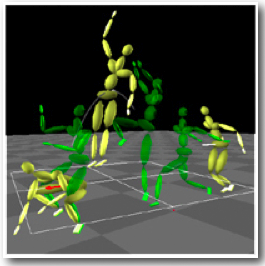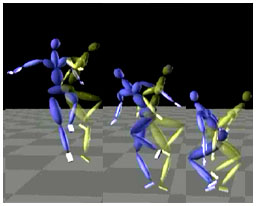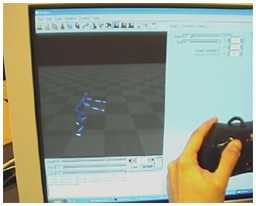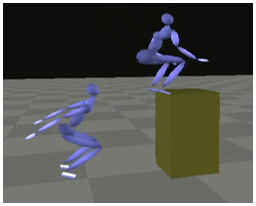Momentum-based Parameterization of Dynamic Character Motion


This paper presents a system for rapid editing of highly dynamic motion capture data. The heart of this system is an optimization algorithm that can transform the captured motion so that it satisfies high-level user constraints while enforcing that the linear and angular momentum of the motion remain physically plausible. Unlike most previous approaches to motion editing, our algorithm does not require pose specification or model reduction, and the user only need specify high-level changes to the input motion. To preserve the similar dynamic behavior of the input motion, we introduce a spline-based parameterization that matches the linear and angular momentum pattern of the motion capture data. Because our algorithm enables rapid convergence by presenting a good initial state of the optimization, the user can efficiently generate a large family of realistic motions from a single input motion. The algorithm can then populate the dynamic space of motions by simple interpolation, effectively parameterizing the space of realistic motions. We show how this framework can be used to produce an effective interface for rapid creation of dynamic animations, as well as to drive the dynamic motion of a character in real-time.
Papers
Abe, Y., Liu, C. K., and Popović, Z. Momentum-based Parameterization of Dynamic Character Motion ( ACM SIGGRAPH / Eurographics Symposium on Computer Animation 2004 )
Abe, Y., Liu, C. K., and Popović, Z. Momentum-based Parameterization of Dynamic Character Motion ( Graphical Models, Article in Press )
Video

Rapid editing of two consecutive broad jumps from a motion capture sequence ( mp4 , 10M, with audio)

A family of volley ball motions that parameterizes the space of landing position ( mp4 , 6.9M, with audio)

Interactive control of a realistic motion ( mov , 19.8M, with audio)

Physically non-realistic motion ( mp4 , 1.6M)
Project members
This research is supported by
University of Washington Animation Labs
National Science Foundation
Information Technology Research
Alfred P. Sloan Fellowship
Electronic Arts
Sony
Microsoft Research